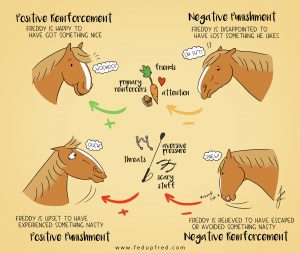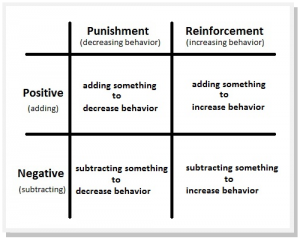Operant Conditioning – Reinforcement and Punishment (7 min)
Operant conditioning is a theory of behavior and motivation put forward by behaviorist, B.F. Skinner . The theory lays out two types of motivation for behavior which are reinforcement and punishment. The idea is that any action that is followed by a reinforcer will be strengthened, while any action that is followed by a punishment will be reduced. This theory deals mainly with extrinsic motivators. We discuss this in more detail in section 4.
Reinforcements can be both positive and negative. Positive reinforcement means something of value or something pleasant happens or is given, negative reinforcement means that something unpleasant is avoided or taken away.
Likewise, punishments can be negative or positive. Positive punishment is when something unpleasant is added or happens as a result of a behavior. Negative punishment is when something good is taken away or stops happening.
Positive Reinforcements
Positive reinforcements in the workplace are rewards or incentives that are earned by employees when they meet a set goal or standard for performance. Positive reinforcements are good for keeping morale high, incentivizing good performance and creating a positive atmosphere in the workplace. These might include:
- Praise – this can be verbal or written and might be delivered privately or publicly.
- Awards – these might be formal certifications or more informal recognition like an ‘employee of the month’ trophy.
- Financial Rewards – these include sales commission, pay increases and bonuses, or a promotion to a role with higher pay.
Negative Reinforcements
Negative reinforcements in the workplace are the removal of an unpleasant stimulus. These are less common in the workplace as usually, the company will strive to make working conditions as comfortable as possible. However, these might include:
- Permission to Skip a Boring Meeting – e.g. if we meet our goal this week, we will cancel the weekly sales report meeting and you can all go home early instead.
- Improve the Working Environment – e.g. allowing workers in a noisy office to use earphones to listen to music if they are performing well.
Positive Punishments
Positive punishments are when something unpleasant happens as a result of the behavior. These are perhaps the least common in the workplace, but might include:
- Reprimand – this might be a verbal or written reprimand delivered to the employee.
Negative Punishments
Negative punishments in the workplace are when something of value is taken away, such as:
- Demotion or Firing – if expectations are consistently unmet, an employee may lose their job or some of their responsibilities.
- Financial Consequences – reduction in working hours or pay as a consequence of poor performance or unacceptable behavior.
- Exclusion from Group Rewards – such as losing a place on a team-building or reward outing with the rest of the team.
These different kinds of reinforcements and punishments can be used to motivate people in the workplace. When used together and in balance, they can be effective at keeping employees on track and motivated to perform well.
Check out this great video (3 min) which uses the example of students and teachers to demonstrate the different elements of operant conditioning.



